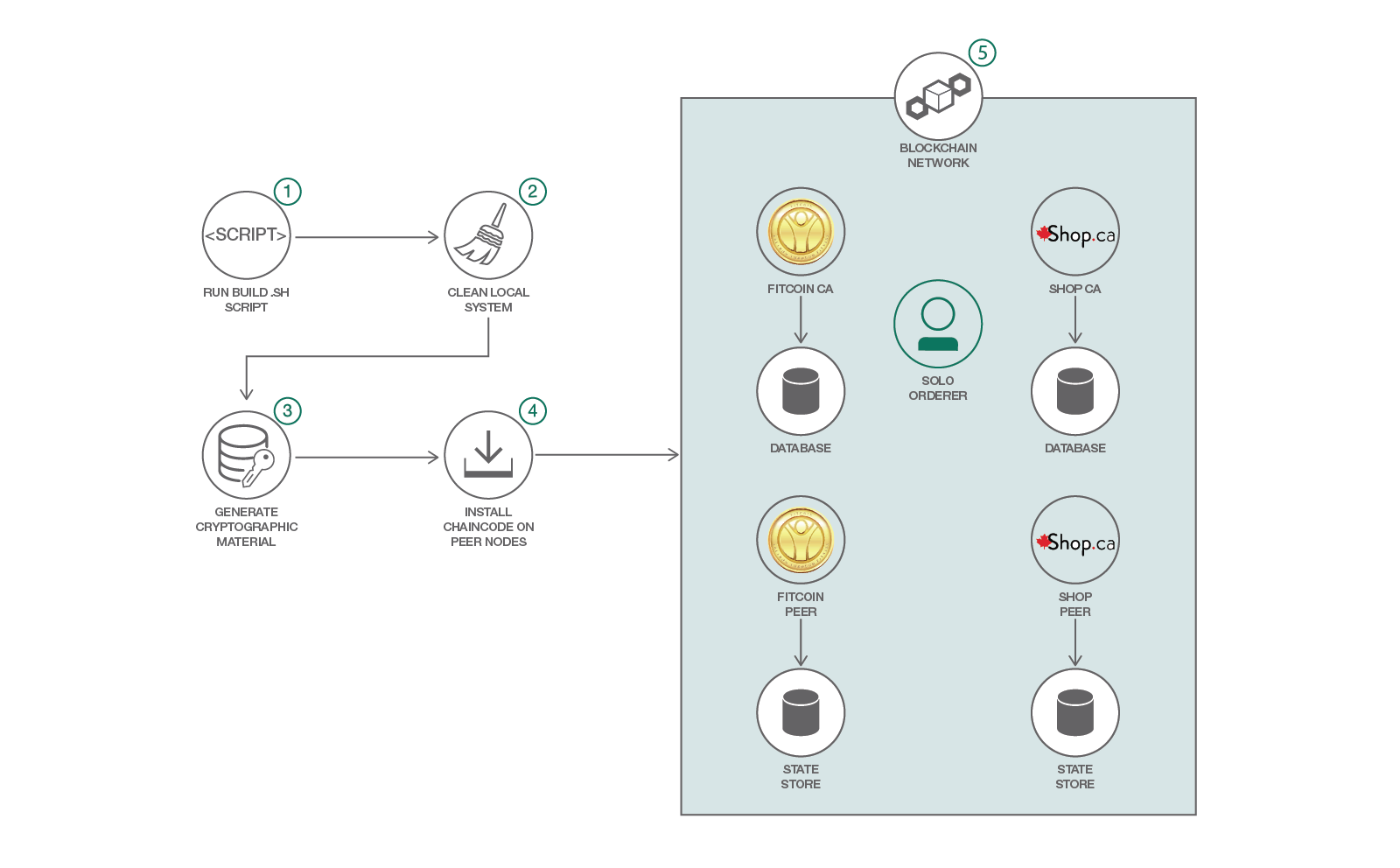IBM / Fabricnodesdk Starter
Programming Languages
Projects that are alternatives of or similar to Fabricnodesdk Starter
WARNING: This repository is no longer maintained ⚠️
This repository will not be updated. The repository will be kept available in read-only mode.
Creating and Deploying a Blockchain Network using Hyperledger Fabric Node SDK
Read this in other languages: 한국어
Instructions for setting the blockchainNetwork
Welcome to Part 1 of building a Blockchain Application. This first pattern is part of a larger application that uses blockchain as a back-end to record fitness activities and manage transactions such as handling acquisition of products via fitcoins. The first step in this series is focused on creating and deploy a Hyperledger Blockchain Network using the Hyperledger Fabric Node SDK. We have two participants, namely a buyer and seller/shop peers. The buyer is the one who downloads the application and subsequently registers his steps on the blockchain. The seller is the one who verifying that the buyer has the right number of fitcoins to make purchases. A developer who has a lite account can run this application locally or adapt it to the IBM Blockchain Starter Plan.
Included Components
- Hyperledger Fabric
- Docker
- Hyperledger Fabric SDK for node.js
Application Workflow Diagram
Prerequisites
- Docker - v1.13 or higher
- Docker Compose - v1.8 or higher
Steps
- Run Build.sh Script to build network
- Start the Network
- Check the logs to see the results
- Check the Blockchain Network
1. Run the Build.sh Script
This accomplishes the following:
a. Clean up system by removing any existing blockchain docker images
b. Generate certificates
- The
crypto-config.yaml(Crypto configuration file) defines the identity of "who is who". It tells peers and orderers what organization they belong to and what domain they belong to.
c. Create Peers, Orderers and Channel
- The
configtx.yamlfile initializes a blockchain network or channel and services with an Orderer Genesis Block which serves as the first block on a chain. Additionally, membership services are installed on each channel peer (in this case, the Shop and Fitcoin Peers).
d. Build docker images of the orderer, peers, channel, network
Open a new terminal and run the following command:
export FABRIC_CFG_PATH=$(pwd)
chmod +x cryptogen
chmod +x configtxgen
chmod +x generate-certs.sh
chmod +x generate-cfgtx.sh
chmod +x docker-images.sh
chmod +x build.sh
chmod +x clean.sh
./build.sh
2. Start the Network
Make sure the 'LOCALCONFIG' environment variable is unset if you are re-running this step after running the test below
unset LOCALCONFIG
There 2 options to install chaincode on the peer nodes and start the Blockchain network. You can select any one of the following:
- Using LevelDB to store the blockchain state database. Run the following command to start the network:
docker-compose -p "fitcoin" -f "docker-compose.yaml" up -d
- Using CouchDB to store the blockchain state database. Run the following command to start the network:
docker-compose -p "fitcoin" -f "docker-compose-couchdb.yaml" up -d
3. Check the logs
You will see the results of running the script
Command
docker logs blockchain-setup
Output:
Register CA fitcoin-org
CA registration complete FabricCAServices : {hostname: fitcoin-ca, port: 7054}
Register CA shop-org
CA registration complete FabricCAServices : {hostname: shop-ca, port: 7054}
info: [EventHub.js]: _connect - options {"grpc.ssl_target_name_override":"shop-peer","grpc.default_authority":"shop-peer"}
info: [EventHub.js]: _connect - options {"grpc.ssl_target_name_override":"fitcoin-peer","grpc.default_authority":"fitcoin-peer"}
Default channel not found, attempting creation...
Successfully created a new default channel.
Joining peers to the default channel.
Chaincode is not installed, attempting installation...
Base container image present.
info: [packager/Golang.js]: packaging GOLANG from bcfit
info: [packager/Golang.js]: packaging GOLANG from bcfit
Successfully installed chaincode on the default channel.
Successfully instantiated chaincode on all peers.
4. Check the BlockchainNetwork
Execute the following commands to to test the network by performing the invoke and query operations on the network:
cd configuration
export LOCALCONFIG=true
node config.js
cd ..
cd test/
npm install
If you are using LevelDB, then run the following command:
node index.js
If you are using CouchDB, then run the following command:
node indexCouchDB.js
Additional Resources
License
This code pattern is licensed under the Apache Software License, Version 2. Separate third party code objects invoked within this code pattern are licensed by their respective providers pursuant to their own separate licenses. Contributions are subject to the Developer Certificate of Origin, Version 1.1 (DCO) and the Apache Software License, Version 2.

